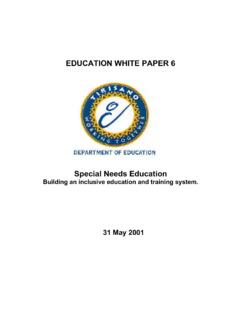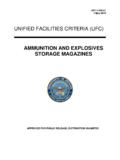Transcription of BUILDING COMMUNITY IN THE CLASSROOM - Whole …
1 Helping students BUILDING COMMUNITY . Fostering COMMUNITY awareness by creatingstructures that emphasize collaborative activityand joint problem-solving. Modeling the language of cooperation (eg. friends help friends. We all work together .) Extending COMMUNITY - BUILDING efforts to allareas of CLASSROOM activity, finding places wherestudents can assist each other. Reinforcing the notion that all ideas in thecommunity are respected and valued. Providing visible cues throughout the classroomthat encourage collaboration and cooperation(eg. Posters highlighting a Cooperative WorkEthic; seating arrangements). Strategic planning for the arrival of new studentsto the CLASSROOM (eg. Assigning a friend to eachnew student to provide support, guidance, andleadership). Modeling collaboration, making teachers collaborative planning activities visible tostudents.
2 Play group games that foster communitybuilding and read literature that teaches CCCCOOOOMMMMMMMMUUUUNNNNIIIITTTTYYYYIIII NNNN TTTTHHHHEEEE CCCCLLLLAAAASSSSSSSSRRRROOOOOOOOMMMMby Mishael Elementary SchoolSouthfield, MichiganInternational Education SummitDetroit, MichiganJune 26, 2000As teachers, we have a very difficult job. We are to take a group of diversestudents and teach them in ways that meet all of their needs on every level:academic, emotional, and social. Yet, students come to us with many differentstrengths and abilities. They also come to us with pain and hurt in their lives. Ourchallenge is to create a classroomculture that builds on their strengthsand heals their hurts so that learningcan definition, a COMMUNITY is agroup of people who work with oneanother BUILDING a sense of trust, care,and support. This means that in ourclassrooms, part of our job is toprovide opportunities and structures bywhich students can help and supportone another.
3 It also means that weprovide explicit instruction and supportso that students learn how to do I ve worked to build COMMUNITY inmy CLASSROOM , I ve realized that it isconnected with everything I I have found a way tostructure how I think about VoiceMaking choices. Children both need help from adults to provide structure in theirlives and freedom to make choices. Students need to take responsibility forchoices as part of their growing and learning. I establish many ways to givestudents reasonable choices on a daily basis. Often I present options to the entiregroup and allow students to select through a democratic show of hands. Someother examples include:What to learn. At the beginning of the year and at the beginning of each unit, Ifind out what students would like to learn and incorporate their ideas into order: Students sometimes choose order of work activities.
4 Should they learnthe new lesson or go over homework first? Do reading workshop or writingworkshop first?Choice Time. I structure time every day for students to participate in any of severalspecified choice activities. This is not free time, as the activities are all structuredaround a topic, such as literacy, science, or social to read/write. Students are given choices about what books to read or whatstories to write. Even when I select the genre to read or write, the student selectsthe to day goals. Kids choose weekly goals to set for themselves in terms of eitheracademics or behaviors. They are required to think reflectively to choose goalsthat they think need improvement. Again, this is their choice not me to sit. For most activities, where to sit is not really the key issue. I letstudents choose where to sit, as long as it does not impede their work is also very important for children to feel like the class is theirs and notjust the teachers.
5 This adds to a feeling of responsibility and helps children learn totake care of their things. As I get started at the beginning of the year, I rememberthat first impressions, for adults as well as kids, can be lasting ones. I seek fromthe beginning to set the tone and build a culture of mutual support in our ways I encourage this feeling early on are to decide as a group how the roomwill be set up (this year I am holding a room decorating party), what the bulletinboards should be for, and what the CLASSROOM rules should be. With little direction,students often come up with the same ideas I would have chosen. Sometimes theysurprise me and come up with better FriendsIt is very important for children to get to know each other and see each other asindividual people. They can learn to respect and appreciate differences and enjoythings that are the same.
6 This adds a great deal to the feeling that we are a familyof people here to learn together. Some things to do to encourage this are: Instead of taking general recess time, set aside some time during the day to playa game together. On Mondays share their weekends and other things that make them happy orworry them. At the beginning of each day, hour, right after recess, or wherever it seems towork best have children talk with a friends about anything they want to. Thisgives them a chance to share feelings with people. Do fun work together, like art projects Arrange activites with their families outside of the normal school day. Play educational games teachers, including myself, take the first two weeks of school to reallyconcentrate on getting to know each other and BUILDING COMMUNITY . Thisfoundation serves well to prevent future problems and provide a respectful way ofdealing with those problems that do RespectDaily routines.
7 In my experience, we either make or break COMMUNITY in thesmallest of daily routines. We either treat simple issues in ways that build respectand teach responsibility or in ways that are controlling. In elementary schools,going to the bathroom is an excellent example. I see one class lined up at thebathroom. The teacher is admonishing the children in line to stay quiet, whichonly a few of them were doing, and is trying to rush the children through thebathroom. The noise of laughter and scuffling around is easily heard through thedoor. In about 20 minutes, the teacher manages to get all of the children out of thebathroom and back to the class to work. Sound familiar?In my class, the children wave one of two bathroom passes to ask permission toleave without interrupting and I nod yes. I check the clock to make sure they arenot gone too long. Most of the children go to the bathroom without outsidersreally knowing that they were gone.
8 Many children even try to wait longer so theywon t miss fun things in solution teaches children to be responsible fortheir own actions, while not wasting learning and other issues can have a significant impact on the COMMUNITY feelingin the CLASSROOM . If we are teaching students how to function as responsible adults,not controlled children or inhabitants of institutions, we must develop strategies bywhich students are given daily responsibility and supportive structures for them todo so. In each basic daily routine I think about ways to make it fun and teachresponsibility at the same time. Here are typical routines and some strategies thatbuild COMMUNITY and class attention. Clap hands in a rhythm students imitate, ring a bell orother musical instrument, hold up a silent hand and count down while children joinin, or quietly ask each group to put their eyes on the teacher.
9 Involve the kidsthemselves in figuring out attention getting between areas or activities. Begin singing a song all know, ask kidsto fill in blanks in funny story, start reading a poem, begin a Have a signal to ask permission silently, use a bathroom pass, provideconsequences for Up. Have children lead with teacher following, stopping at key Count. Use a magnetic board with one column for hot and cold students move their magnetic ticket to hot/cold lunch and another studentcharged with the job of pulling tickets and sending information to the Set a routine for leaving room. Assign jobs needed for straightening Students take attendance on a sheet, passing it around,or studentchecks off names on a printed of Voice: When you are done writing please match eyes with me and Iknow we can go on. This is an example of a respectful strategy by which tointeract with students in the class moving from topic to topic.
10 Kids need to feelaccepted in class and it is very important not to embarrass students or put them onthe spot. Anytime students don t want to talk, they just say pass . Then they willbe more likely to respond at a later time. If they pass all the time, I talk with themindividually. I try to always talk in a respectful manner, so that I am modeling whatI want them to do. If I yell at them, doesn t it make sense that they will be rudeback?Difficult Students: We probably send the biggest messages about respect to all ofour students when they see us handle the most difficult students. In my fourthgrade class two years ago, I was having difficulty with a girl who was arguinginsistently. While I tried to stay calm, I finally began yelling. Another studentmumbled, Great! Now she will be mad at all of us. There goes this day. Whenother students see that I treat all students with respect, they are more comfortabletaking risks and sharing things about themselves.








